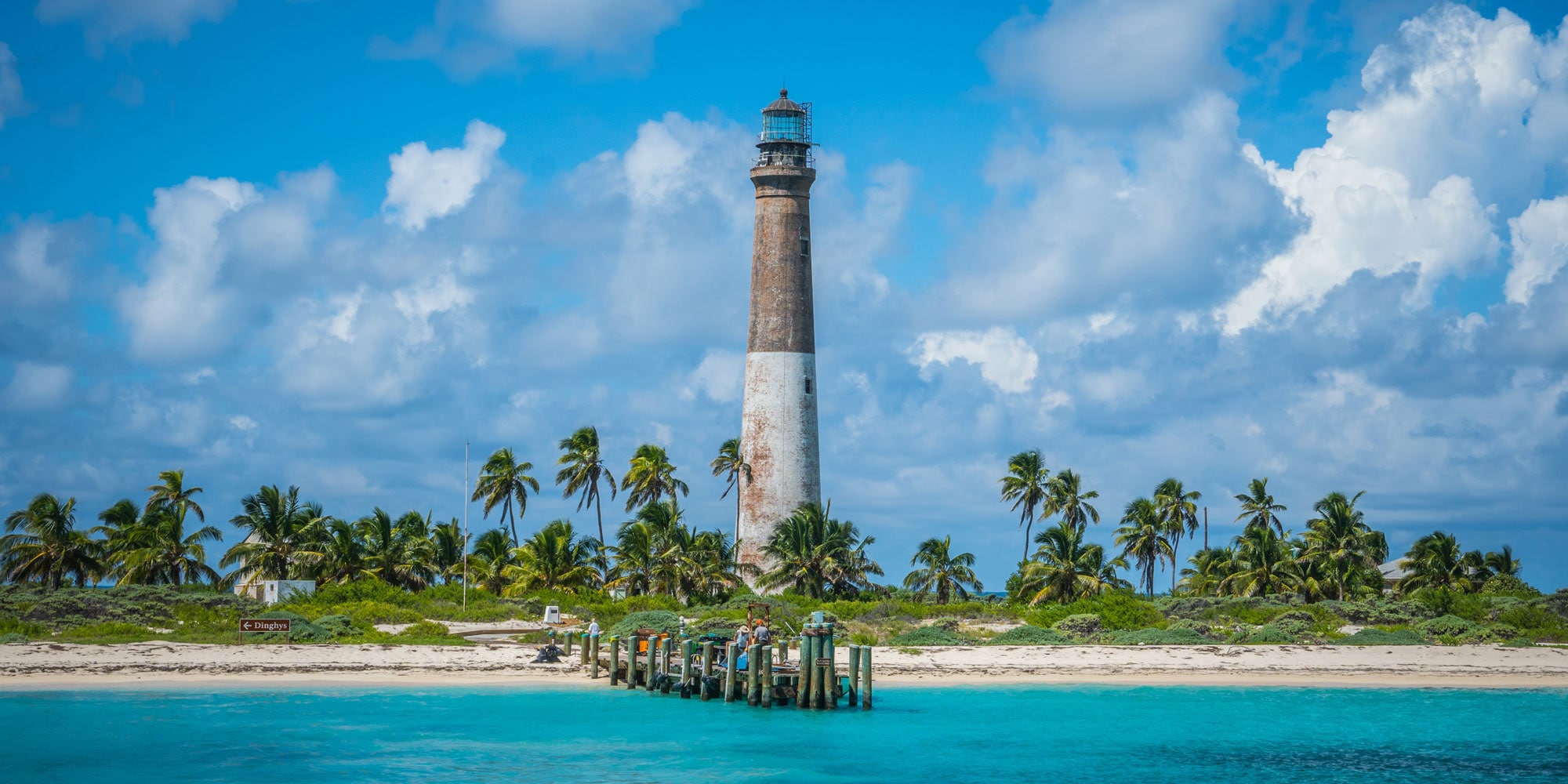Winter camping doesn’t have to mean cold nights, thick sleeping bags and snow-covered tents. It can just as easily involve T-shirts, sunscreen and, most importantly, warm weather. All you have to do is head south. From the Florida Keys to the American Southwest, here are some of our favorite campsites for a little fun in the mid-winter sun.
1. Dry Tortugas National Park
Florida
Average January temps: High of 74°F, low of 65°F
Encompassing seven small islands in the outer reaches of the Florida Keys, Dry Tortugas is about as far south as you can go and still be in the United States. And you’ll need to catch a boat to get there because the nearest road ends at Key West, about 70 miles to the east. But if you make that winter migration, you’ll be rewarded with 70°F days, white sand and turquoise water teeming with coral and fish.
Camping is limited to the primitive sites on Garden Key just outside of the walls of Fort Jefferson, a Civil War prison. You could stick to Garden Key and spend your time lounging beneath the palm trees with your toes in the sand, snorkeling from the swimming beach and exploring the historic fort, but the real action is offshore. If you’re up for it, rent a kayak in Key West and make the 3-mile paddle from Garden Key to Loggerhead Key, the largest island in the park, complete with a lighthouse, lonely beaches and massive reefs and shipwrecks ideal for snorkeling.
Fees: $15 camping fee per night, first come, first serve. The Yankee Freedom ferry operates daily trips for visitors and campers for $200 per adult.
2. Death Valley National Park
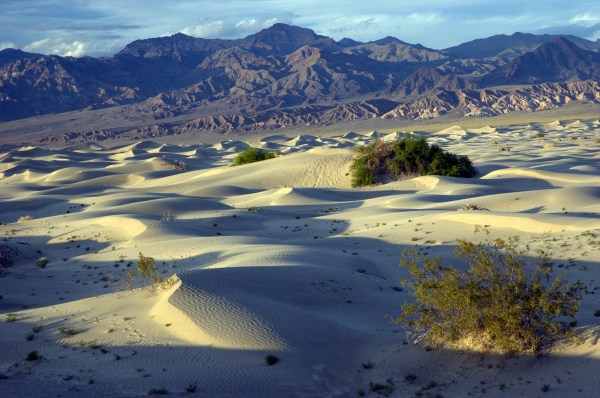 California and Nevada
California and Nevada
Average January temps: High of 67°F, low of 40°F
You don’t want to spend too much time in Death Valley during the summer, but mid-winter? This otherwise inhospitable desert is downright pleasant with highs in the 60s. The landscape is diverse, ranging from soft, shifting sand dunes to 11,000-foot peaks known to gather snow.
Pitch your tent in Wildrose Campground, which is sandwiched in the middle of the mellow Wildrose Canyon and coveted for both its isolated location (it’s 30 miles from the nearest highway) and proximity to much of the Death Valley action. Head to the back of the 24-site facility for tent-only sites (which come with a table, fire pit, grill and access to a pit toilet), and you’ll be within striking distance of 11,049-foot Telescope Peak, the highest mountain in the park. It’s a full summit mission via the 6-mile, 3,100-foot climb that passes old-growth bristlecone pines (some more than 5,000 years old) along the way. The peak is a narrow, rocky ridge with the best view in the park.
Fees: $30 entrance fee, no camping fee, first come, first serve
3. Valley of Fire State Park
Nevada
Average January temps: High of 57°F, low of 39°F
If you think the Valley of Fire State Park’s name is dramatic, wait until you see the terrain first-hand. The 40,000-acre park is packed with orange and red sandstone formations that roll across the landscape in waves, stick out from the desert floor in tall spires and cliffs, or form narrow canyons and whimsical arches. The park has two campgrounds. The Atlatl Campground’s 44 sites are hemmed in by a bowl of rock and come with all the amenities including a table, grill, water and bathrooms. Head to the back of the loop where three walk-in sites will get you away from the RVs. There isn’t a tree or light in sight, so the stargazing is off the charts. When the sun comes up, check out the White Domes Trail, which forms a 1.1-mile loop through a narrow slot canyon, or look for the 2,500-year-old petroglyphs along the .4-mile Mouse’s Tank Trail.
Fees: $10 entrance fee, $20 camping fee per night, first come, first serve
4. Monument Valley Navajo Tribal Park
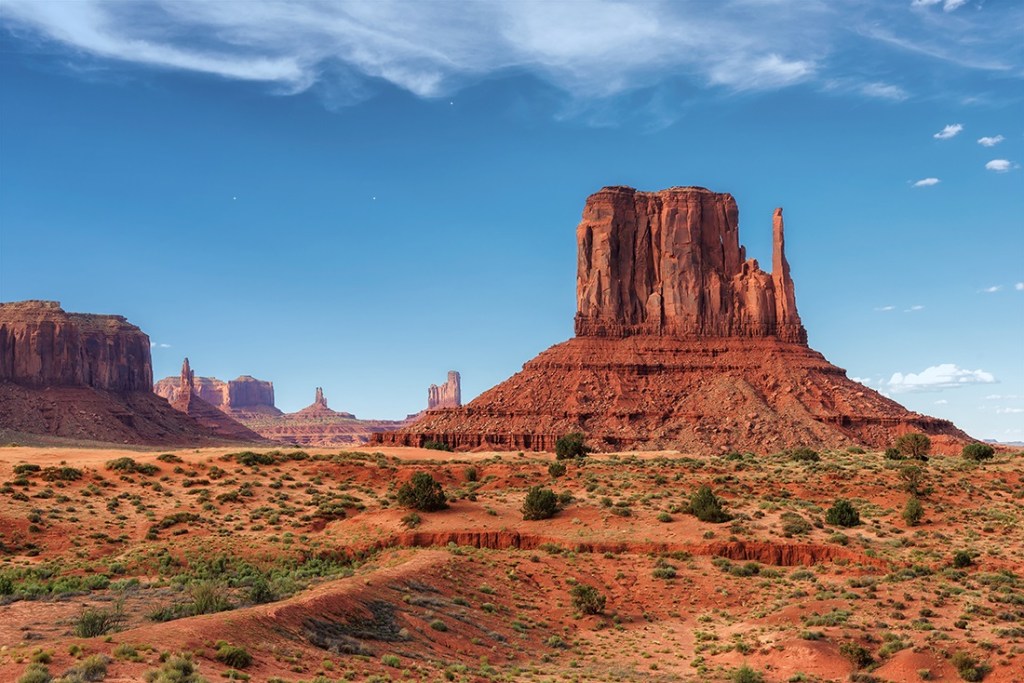
Arizona
Average January Temps: High of 42°F, low of 25°F
This 92,000-acre tribal park of the Navajo Nation, which stretches across the borders of Utah, Arizona and New Mexico, is one of the most iconic landscapes in the West. Picture an impossibly flat desert floor with massive sandstone towers rising 1,000 feet into the sky. It is Instagram bait in the best way. Head to the cliff-side The View Campground for tent sites that overlook some of the valley’s most recognizable landmarks (including Mittens, which are two tall buttes that look a lot like, well, mittens). The campground has restrooms with showers, so you’re not necessarily roughing it. It’s tempting to just hang out tent-side and gaze on the valley below, but you’re better off driving the 17-mile loop road through the heart of the park ($20 entrance fee per car) and tackling the 4.1-mile Wildcat Trail, the only self-guided hiking path inside the park, which will put you at the base of several towering buttes. If you want to explore farther, you’ll need a local guide from the Navajo Nation.
Fee: $42 per night
5. White Sands National Park
New Mexico
Average January Temps: High of 57°F, low of 22°F
America’s newest national park protects the largest gypsum dune field in the world, where waves of white, powdery sand roll against the horizon for 275 square miles. There are only a handful of established paths, including the Dune Life Nature Trail, an intermediate, .09-mile crash course in dune travel (climbing the hills isn’t as easy as it looks). When you’re ready, head out on the Alkali Flat Trail, a tough, 5-mile romp up and down steep dunes along the edge of what’s left of Lake Otero, the ancient body of water that once covered the basin.
Spending the night in White Sands means hiking the 1.7-mile Backcountry Camping Trail and pitching a tent in one of the primitive sites among the dunes. There aren’t amenities, so pack in everything you need and practice leave no trace principles. While the winter days are balmy, often reaching the low 60s, it gets below freezing at night, so pack accordingly. You should also consider bringing a telescope and a camera with a tripod because the sky above the dunes is full of stars.
Fees: $20 entrance fee per vehicle, $3 camping fee per night per adult.
6. Santa Catalina Island
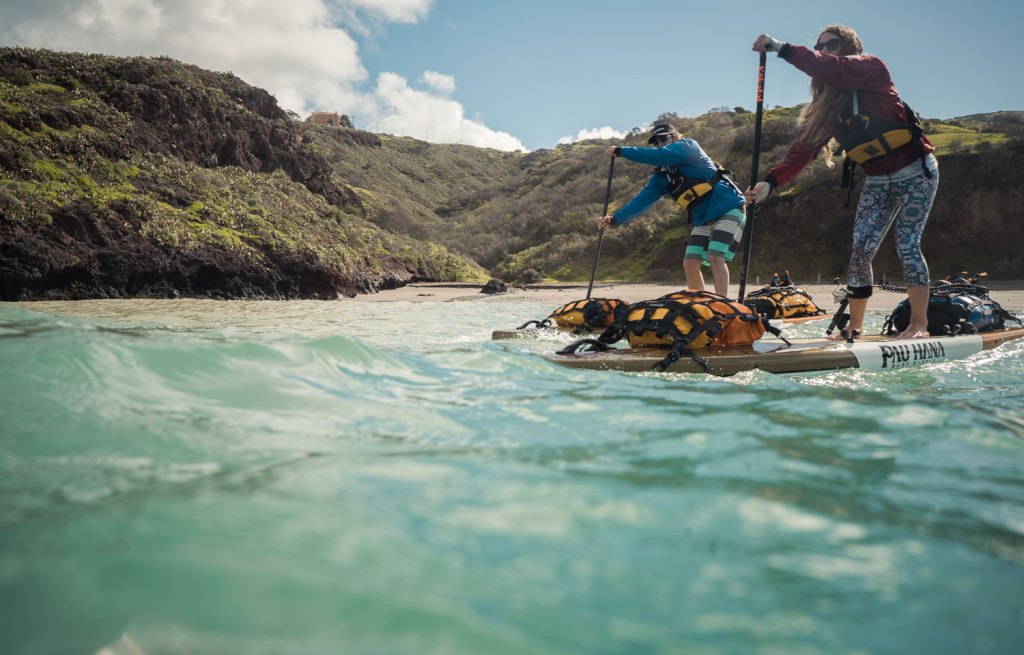
California
Average January Temps: High of 60°F, low of 43°F
Santa Catalina Island has been luring tourists into the Pacific Ocean for decades, but most of them stick to the resort town of Avalon. That leaves the rest of the 22-mile-long island’s rugged canyons, rocky mountains and isolated beaches yours to explore. Most of the island is protected by the Catalina Island Conservancy, which manages more than 165 miles of trails and jeep roads, including the 39.6-mile Trans-Catalina Trail.
Pitch a tent 7 miles west of the village of Two Harbors at Parsons Landing Campground, which has eight tent sites on a secluded beach surrounded by tall cliffs. The sites are primitive with no shade or running water, but you can purchase a locker key ($20) for access to a box containing 2.5 gallons of water and firewood. Grab site number one, separated from the rest by its cove. Kayaking and snorkeling are popular, but hiking is also a big draw. Hoof it up the 1.4-mile-long Hermit Gulch Trail, which climbs from the belly of a canyon to its rim for 360-degree views, or head to the southwest side of the island, where a series of small beaches await.
Fees: $19 per night per adult during the winter; Catalina Express, from Long Beach, $75 round trip per adult
7. Big Bend Ranch State Park
Texas
Average January Temps: High of 62°F, low of 30°F
The Rio Grande makes a dramatic left turn through the Chisos Mountains in the southwest corner of Texas, dividing the United States and Mexico in the process. The area known as “Big Bend” is largely protected by public land, and while Big Bend National Park grabs most of the attention, its neighbor Big Bend Ranch State Park has similar terrain, plus other-worldly mountain biking and pristine backcountry camping. Grab a four-wheel-drive vehicle and head deep into the 300,000-plus-acre green space (the largest state park in Texas), where roadside campsites abound. The three-site Grassy Banks Campground will put you next to the Rio Grande. Or head to the Guale 2 site, on the rugged East Oso Loop, which has tent pads with views of canyons and buttes. Bring your mountain bike and pedal some of the park’s 70 miles of trails through fields of crystal or to a desert oasis complete with a waterfall. Just don’t ignore the national park altogether. We suggest spending a day soaking in its hot springs next to the Rio Grande, which have an uninterrupted view of Mexico.
Fees: $5 entrance fee per person, $12 camping fee per person
8. Everglades National Park
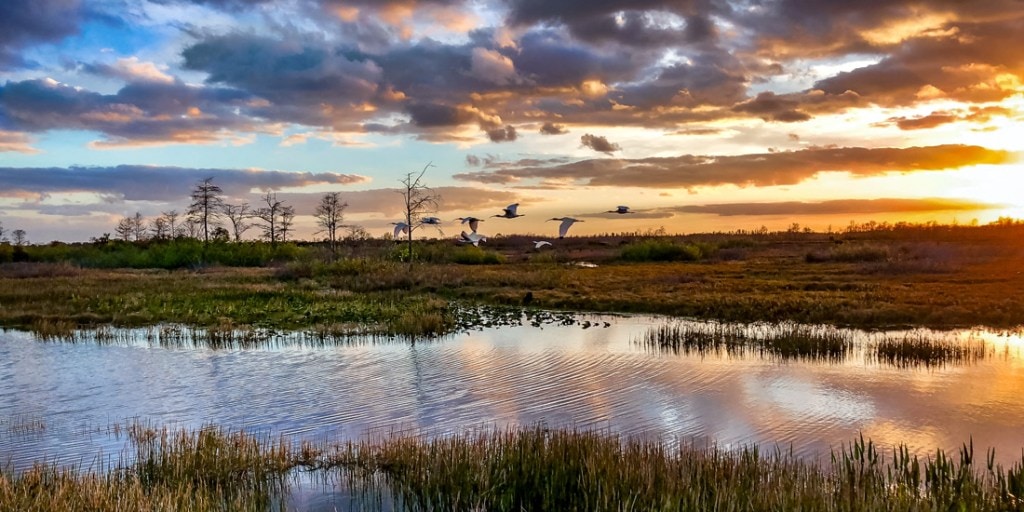 Florida
Florida
Average January Temps: High of 76°F, low of 50°F
South Florida’s Everglades National Park protects more than 1.5-million acres of wetlands. The tangle of slow-moving rivers, sawgrass marshes and mangrove jungles also protects some of the most impressive species in the country, from endangered leatherback turtles to West Indian manatees (not to mention more than a few alligators). It’s a soggy safari best explored by canoe or kayak in the dead of winter, when the bugs have abated and temperatures hover in the mid-70s. For the full Everglades experience, though, you should spend a few nights on a “chickee,” a wooden camping platform that keeps you off the water and out of the way of predators. There are more than two dozen chickees scattered throughout the park (plus plenty of primitive, paddle-in beach sites), but they’re popular during the winter, so it’s smart to have a few options in mind in case your first choice is booked. The Crooked Creek Chickee is a double platform with a pit toilet that’s a 9-mile paddle from the Gulf Coast Visitor Center in Everglades City. You’ll be able to catch both the sunrise and sunset from its high vantage point, and have countless options for exploring the park’s iconic Ten Thousand Islands.
Fees: Get your backcountry permit at the Gulf Coast Visitor Center. Winter permits are $15 and camping is $2 a night per person.
